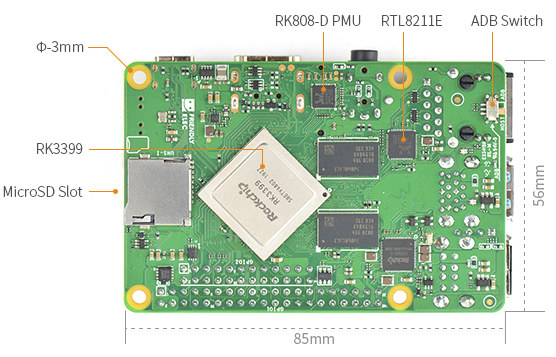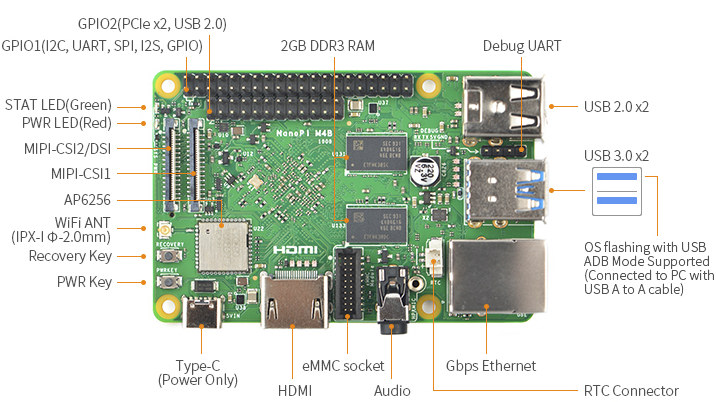NanoPi M4 was launched last year (2018) as a Rockchip RK3399 SBC following Raspberry Pi 3B+ form factor with 2 or 4GB DDR3 RAM, and was followed by NanoPi M4V2 this September with 4GB LPDDR4 memory, and power & recovery buttons.
FriendlyELEC has been working on yet another revision with NanoPi M4B mixing some of the features of M4 and M4V2 such as DDR3 memory and power & recovery buttons, but the biggest change is the removal of the USB 3.0 hub which allowed for four USB 3.0 port, and now the company is going native leveraging the two USB 2.0 interfaces and two USB 3.0 interfaces inside Rockchip RK3399 processor which should lower the BoM cost, and in some cases improve performance.
- SoC – Rockchip RK3399 big.LITTLE hexa-core processor with 2x Arm Cortex-A72 @ up to 2.0GHz, 4x Cortex-A53 @ up to 1.5GHz, a Mali-T864 GPU with support OpenGL ES1.1/2.0/3.0/3.1, OpenVG1.1, OpenCL, DX11, and AFBC, and a VPU with 4K VP9 and 4K 10-bit H265/H264 decoding
- System Memory – Dual-channel 2GB DDR3
- Storage – eMMC module socket, MicroSD card slot
- Video Output
- HDMI 2.0a up to 4K @ 60 Hz with HDCP 1.4/2.2 support
- 4-Lane MIPI-DSI connector (multiplexed with 1x MIPI CSI)
- Audio – 3.5mm headphone jack with stereo audio, HDMI digital audio output
- Camera – One or two 4-lane MIPI-CSI connector(s) (one multiplexed with MIPI-DSI), dual ISP up to 13MP
- Connectivity – Gigabit Ethernet, dual-band 802.11 a/b/g/n/ac WiFi 5 1T1R, Bluetooth 5.0 via AP6256 module, 1x IPX antenna connector
- USB – 2x USB 3.0 ports, 2x USB 2.0 ports, 1x USB 2.0 type-C port
with OTG mode andfor power input - Expansion
- 40-pin GPIO header with 3x 3V/1.8V I2C, up to 1x 3V UART, 1x 3V SPI, 1x SPDIF_TX, up to 8x 3V GPIOs, 1x 1.8V 8-channel I2S
- 24-pin extension port with
2x USB 2.0 interfaces,PCIe x2, 1x PWM, Power key, IR Rx
- Debugging – 4-pin UART header (3V 1.5Mbps)
- Misc – Power key, recovery button, power LED, 1x user LED, 2-pin header for RTC battery, ADB switch
- Power Supply – 5V/3A via USB-C port or GPIO header; RK808-D PMIC
- Dimensions – 85 mm x 56 mm (8-layer PCB)
- Temperature Range – -20°C to 70°C
 The company also changed the wireless module to Ampak AP6256 which brings Bluetooth 5.0 (vs 4.1) to the board but at the cost of losing 2×2 MIMO for WiFi. Finally, an ADB switch was added, I assume to ease Android development and firmware flashing.
The company also changed the wireless module to Ampak AP6256 which brings Bluetooth 5.0 (vs 4.1) to the board but at the cost of losing 2×2 MIMO for WiFi. Finally, an ADB switch was added, I assume to ease Android development and firmware flashing.
There were some issues in terms of bandwidth and software compatibility with the LPDDR4 found in NanoPi M4V2, so it may explain why the company went back to DDR3 memory meaning third party OS like Armbian built Debian or Ubuntu should work out of the box, or with minimal modifications. The company will provide its own firmware images for Ubuntu Desktop 18.04 64-bit, Lubuntu 16.0432-bit, Ubuntu Core 18.04 64-bit, and Android 8. You’ll find more technical details on the Wiki.
At the time of writing, NanoPi M4B is not up for sale yet on FriendlyElec website, but I’d expect the price to be slightly lower than for NanoPi M4 (2GB) which currently sells for $50.

Jean-Luc started CNX Software in 2010 as a part-time endeavor, before quitting his job as a software engineering manager, and starting to write daily news, and reviews full time later in 2011.
Support CNX Software! Donate via cryptocurrencies, become a Patron on Patreon, or purchase goods on Amazon or Aliexpress





